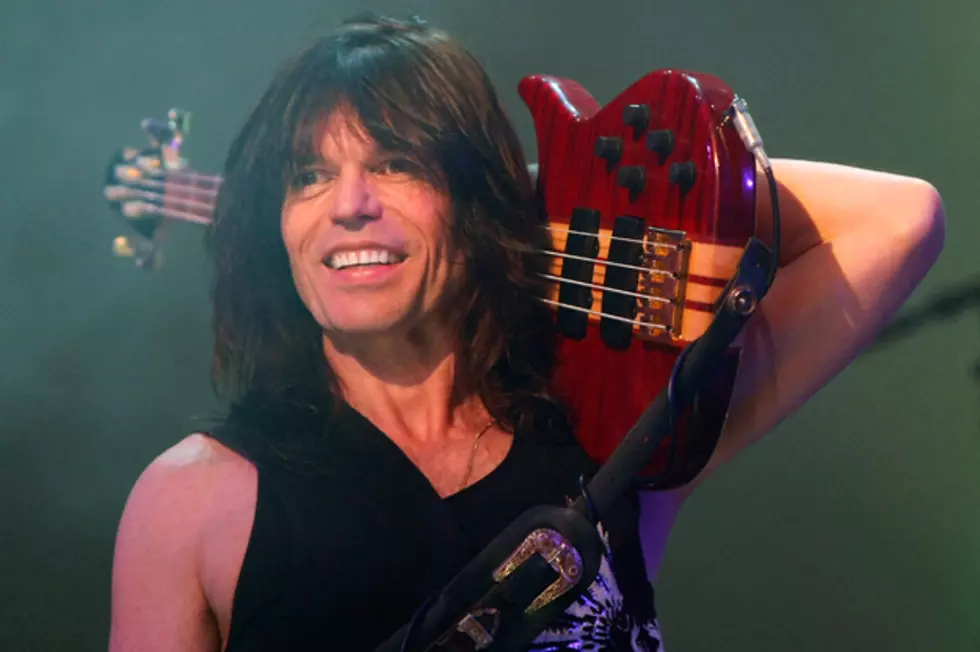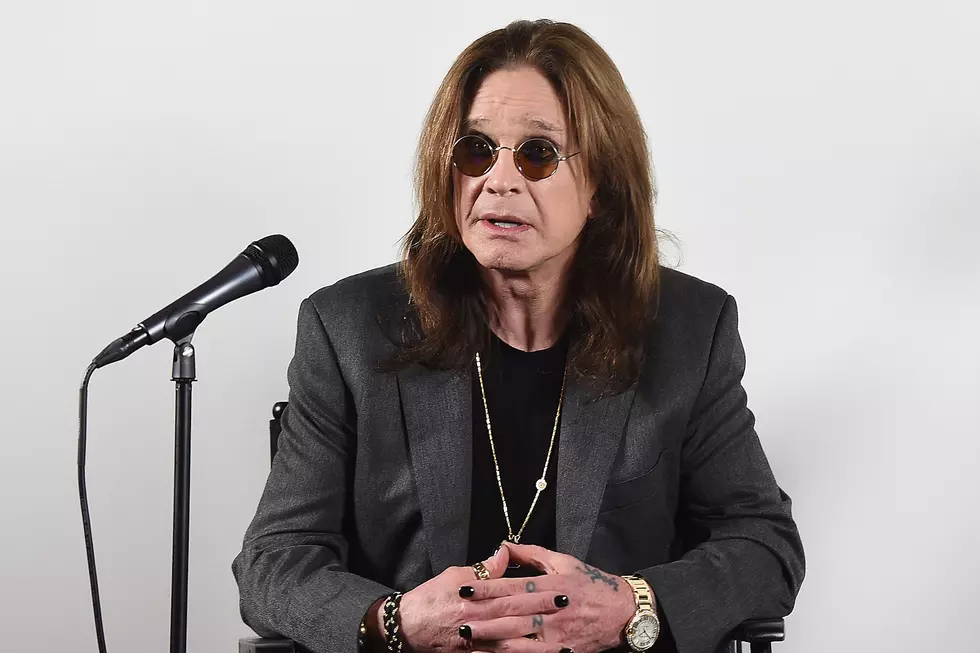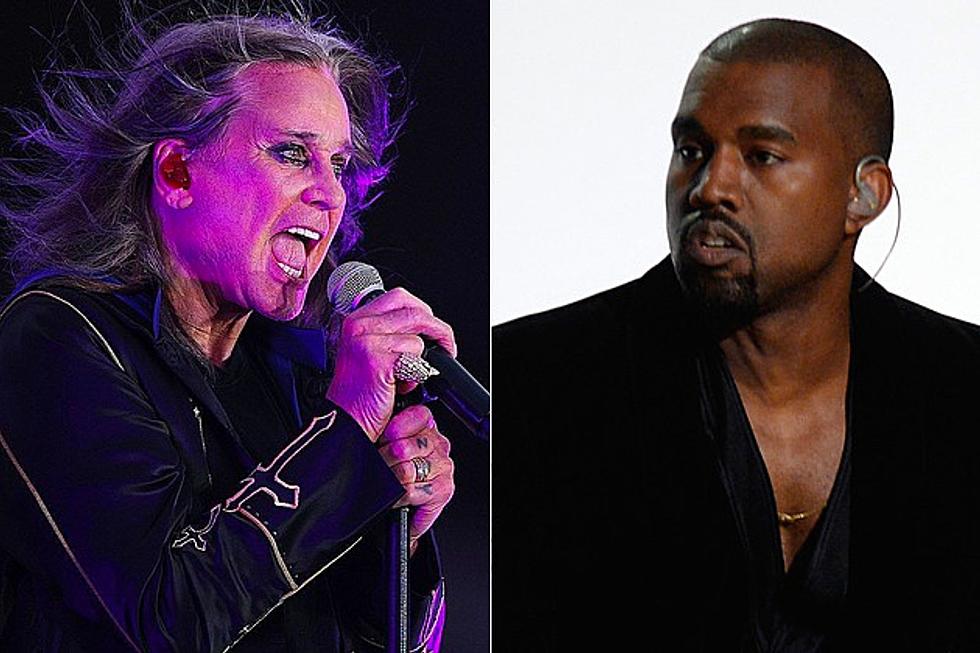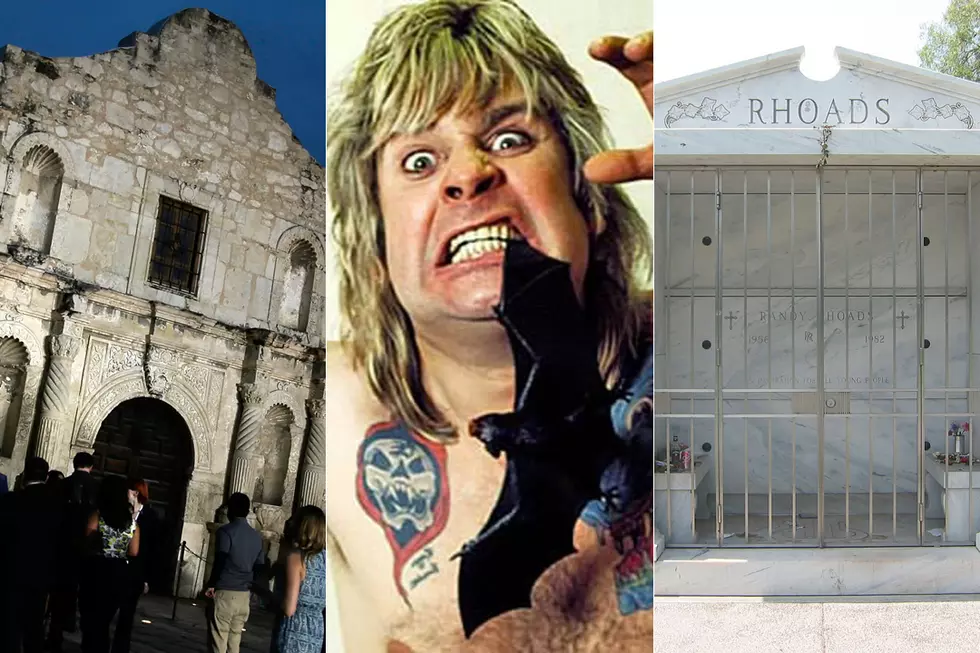
Former Ozzy Osbourne Bassist Rudy Sarzo Recalls His Whirlwind Experience With The Wizard Of Ozz
Bassist Rudy Sarzo’s career, from a gig perspective, has been the stuff that dreams are made of for hopeful musician wannabes. While Sarzo was only in Ozzy Osbourne’s band for less than two years, he was there during a moment of critical rebirth, when the former Black Sabbath frontman was in the process of proving himself as a solo artist.
Osbourne had an extremely prolific period in that time with the emergence of his first two solo albums ‘Blizzard of Ozz’ and ‘Diary of a Madman, which were recorded and released in 1980 and 1981 with barely a year between the two.
While Sarzo wasn’t on the studio recordings, he toured with Osbourne’s band to promote both albums. Sarzo had been recommended for the job by Ozzy’s guitarist Randy Rhoads, who had been Sarzo’s bandmate in an early version of Quiet Riot. In the midst of touring for ‘Diary of a Madman,’ Ozzy and his band were dealt a major blow with the unexpected and tragic death of Rhoads in a plane crash. They made the difficult decision to continue on and finish the tour, eventually recruiting future Night Ranger guitarist Brad Gillis to play the remainder of the shows on the tour.
Sarzo eventually chronicled his experiences on the road with Ozzy and Randy in a book called ‘Off the Rails’ released in 2006, which is essential reading for anyone who would like a real fly-on-the-wall perspective of what it was like to be on the road with the band during that period.
The Gillis-era was caught on film, recorded live at Irvine Meadows for a live MTV broadcast in 1982 which eventually was released on video as ‘Speak Of The Devil.’ Fast forward a lot and it’s finally making its DVD debut in the United States with the release of ‘Speak Of The Devil’ from Eagle Rock Entertainment on July 17.
We had the pleasure of speaking with Sarzo to talk about the new DVD and his time and friendship with Ozzy and Randy, plus additional memories regarding his work with Quiet Riot, Whitesnake, and Ronnie James Dio.
Looking at your career stats, I think that any musician would kill to have the kind of career that you’ve had.
Listen, I’ve been very, very blessed to play with some of the best musicians in rock and roll history! [Laughs]
Absolutely. Well, getting right into things, let’s talk about your run with Ozzy Osbourne. You played with Ozzy for about a year and a half. When you look at your career resume, was the Ozzy gig an important catalyst for everything that would come after that?
Yeah, I think it’s safe for me to say that without having played with Ozzy, we wouldn’t even be having this conversation. You know, that’s the one that opened the door. It has to do mostly I would say because Randy Rhoads introduced me to Ozzy and Sharon. [Without that] I would have never had the opportunity to play in the band and be part of that very legendary historical band.
How fast did that period go by for you? It really struck me, reading your book ‘Off the Rails’, just how much activity was packed into a relatively short time.
It just went by [so fast] ... you know, it’s the closest period to my memory. I can actually flashback on incidents and certain details of being backstage and meeting certain people. You know, like say the Day on the Green, July 4, 1981 [and] Madison Square Garden, post-Randy’s passing and incidents like that. Actually, also the performance on the DVD, because it was a very bittersweet evening. We actually got to finish the North American tour in Irvine, which is basically our hometown, you know, the L.A. area.
To do it without Randy, that was very, very ... to say that it was sad would be understating the situation. I hadn’t seen the footage in 30 years. Actually, the last time that I saw it was when it was broadcast on MTV for Halloween night in 1982. To be able to view it again and to actually take it into consideration and realize what the meaning of that tour had to me personally, knowing what the whole mindset was within the band, after Randy passed away.
I look at that video and I realize that it was a celebration of Randy’s music. Because you know, that was the last tour where Ozzy did the bulk of the set from ‘Blizzard of Ozz’ and from ‘Diary of a Madman,’ plus the medley of ‘Children of the Grave’ with ‘Iron Man’ and ‘Paranoid.’ So it was definitely a celebration of that musical collaboration between Ozzy and Randy, a celebration of our friendship and definitely a triumph of the human spirit, to be able to go on-stage every single night and dig in deep into your soul and be able to come out with a performance that we felt was worthy of Randy’s memory.
It really is something, watching this video, knowing what a turbulent and tragic year it was and everything that was going on behind the scenes. You don’t really see that in the performance. Having Brad Gillis on guitar makes this lineup unique. But beyond that, those two albums were a classic period for Ozzy and there’s not a ton of officially available video from that era, so it’s nice to be able to watch this.
Yeah, you know that video shoot was in the planning for months. Especially in the old days where things did not come together as quickly as they do today with modern technology and making cell phone calls, texting and all of that. So it took a while to prepare. While Randy was still alive, we were all looking forward to that video shoot. We were so blessed to be able to find Brad Gillis, because he really allowed us to finish the tour with dignity, doing justice to Randy’s memory [and] having a guitar player that could actually perform the songs, the way they should be, without Randy being there.
But I’ve got to tell you, being there, that decision that was made to continue with the tour, because of Ozzy’s spiritual [state] and his mindset, he was really a mess. So, if we would have pulled the tour, he would have just gone back home and drank himself to death. I can vouch for that. So in order to keep Ozzy occupied, we just kept the tour going and it was day-by-day with Ozzy, just to make sure that he wasn’t going to hurt himself, basically.
Yeah and you guys were grieving a loss at the time, but at the same time auditioning guitar players and looking to move forward. That had to be a very hard process to do that in that way.
Oh, it was ... you know what, we were so numb from the crash when we were doing that, all we could do as I just mentioned, it was a day-by-day situation to deal with that day and deal with everything. Whether it was auditioning guitar players and then going to services for Randy and Rachel [Youngblood, seamstress for the band] and things like that. We were just numb. Actually, writing the book just gave me closure. I had been carrying all of this on my shoulders, just the weight of the whole experience, for decades and just to be able to put it down on paper, it was a release. It was something that I did not expect to occur and receive like a reward from writing it. But I’ve got to tell you, it was awful times.
It was so bad that it led for me to make the decision to leave the band, because I wanted to enjoy playing again. Actually, I wanted to be able to grieve and for me to decide to leave one of the biggest bands in the world, the Ozzy Osbourne band, to go for the completely unknown with Quiet Riot, that was quite a decision. But at the time, it seemed like the only decision I could make. Otherwise, I would have just stayed with Ozzy until they kicked me out.
At a later point, did you have regrets about that decision?
[pauses] About leaving Ozzy? Well, when I was with Quiet Riot and Whitesnake, I missed playing with Ozzy - I missed his company. I had the best time [with him] - outside of the crash, everything was great. I was treated great by him, Sharon, everybody else ... there was definitely a chemistry and a camaraderie. Yes, of course. But then again, I have those memories, those great memories to look back on say “you know, I was part of something very special.”
You went straight from the Ozzy gig to going back to Quiet Riot. The recently-released DVD of your performance at the US Festival captures the band at a point when they were breaking big, playing what would become one of the most legendary heavy metal events. That was a hell of a transition.
Yeah, it was interesting how the whole thing came about, because I had been ... the reason why Randy recommended me for Ozzy is because of how I played with him previously in Quiet Riot. So at the time that [Quiet Riot frontman] Kevin [Dubrow] had his band called Dubrow - it wasn’t officially Quiet Riot yet and I got this phone call to go in to do a session, one song, as a tribute to Randy’s memory, for a song called ‘Thunderbird’ that he actually wrote after Randy left Quiet Riot to join Ozzy.
Right before I joined Ozzy, I was living in Kevin Dubrow’s apartment, so I used to do all of these gigs with him as Dubrow and one of the songs that we used to perform was ‘Thunderbird,’ so it was actually a song that I already played with him. So I went into the studio and did that at the session, while I was still a member of Ozzy. And then, they asked me, 'Hey, do you remember these other songs we used to do,” you know, ‘Slick Black Cadillac’ and a couple of others.
So by the time I finished that session, I'd already tracked like four or five songs that became the tracks for the ‘Metal Health’ album. But what really hit me was the fact that I was playing on that session with Kevin, who of course I knew from Quiet Riot and Dubrow and I had lived with him, [Quiet Riot drummer] Frankie Banali, who I knew and had played with for many years since the early ‘70s in Florida and [guitarist] Carlos Cavazo, from Quiet Riot. Actually, [I knew Carlos] from Snow, which was one of the bands in the circuit. So it was kind of like “oh wow, I can actually play with these guys and have some sort of emotional refuge from the situation of going back and playing on-stage with Ozzy, without Randy being there.”
Because even though I did get to play with Kevin and Randy Rhoads, it was playing with Ozzy that I spent most of the time with Randy Rhoads, so to me, that’s my reference. Randy with Ozzy was my biggest reference, because while I was in Quiet Riot with Randy, we only really did a couple of dozen gigs, because we were just a local band. Emotionally, it felt like a relief in another band outside of Ozzy, so that’s why I made the decision.
You and Randy Rhoads were such an important pairing. It seems like both artistically and from an inspiration standpoint, you both fed off of each other. What did you gain from playing with Randy?
Oh man, I learned so much. It was incredible. First of all, you know, Randy was a music teacher. And if you take a look at any of the photos of him on stage, the way he holds the guitar, it’s like he’s giving the first 20 rows a guitar lesson. He was very articulate in his choice of notes, his picking, everything. So he was always the teacher on and off the stage. I learned so much from Randy, not just about music, but also about how to handle success. He was great.
You know that he lived at home with his mom until the day he died. That success that he had with Ozzy did not all of the sudden make him go out and get Ferraris or buy houses in the Hollywood Hills. No, he was all about the music. As a matter of fact, during that ‘Diary of a Madman’ tour, he decided to go back to school and get his Master’s Degree in music. So that’s what really mattered to him. So I definitely learned from Randy, one of the things that I can just pick out immediately, is it’s all about the music. No matter how successful you ever become, remember where the success is coming from. It is because you are a musician.
Talking some more about this new DVD: The staging for this tour was incredible. Do you recall any incidents that happened on a particular night because of what a massive production it was?
[Laughs] Oh man, just about every night, but the one that comes to mind first....it’s our opening night at the Cow Palace, December 30th, 1981, that was the opening night and somebody forgot to plug the rod that turns the Kabuki curtain. So when the show started, the curtain did not come down automatically on cue as it should have. So that was mayhem on stage going on, because Ozzy had no idea. He was trapped inside of the magician’s throne - that was the first thing you would see once the Kabuki curtain dropped, it would be the castle, it would be these steps leading up to this throne that Ozzy was inside of and then on cue, when the special effects, the smoke and the fire and whatever came on, Ozzy would appear.
So all of this came on and Ozzy couldn’t see that the curtain wasn’t down, so of course he appears on stage and the curtain is still up. So he grabs this Plexiglass cross and he started pointing it at the curtain like “come on down - I’ve got the power to bring you down!” It was just chaos and mayhem and they actually had to send up a rigger up the scaffolding to loosen up the curtain so that it would drop one piece at a time. People were booing and it was just total chaos, but we bounced back. We just carried on with the show. [Laughs]
You talk in your book about the laser bats, which were inserted into the video after the fact, because they malfunctioned on the night of the shoot.
Yeah, well it wasn’t that they malfunctioned, it was more that....we did a test run of the lasers, which were very popular in the late ‘70s and the early ‘80s. We did a test run at the Oakland Coliseum to [test] what you were going to see on the DVD. So being in an enclosed arena at the Oakland Coliseum, of course you’re going to get the smoke, you’re going to get all of the environmental fog and everything that would make the lasers very sharp and defined.
Now once you take the show into an open air amphitheater such as Irvine, where you’re going to have the wind and everything carrying all of the atmospherics away from the stage, you’re going to find that there’s really no reflection for the lasers to be projected onto, such as smoke and fog and stuff like that. So once they shot the video, they realized that the lasers were not coming in as sharp as possible. So they had to basically reshoot the lasers and superimpose them. They were just minimal little details. The lasers were just an added ingredient into the production - they were never really a significant part of the production.
It’s striking that you were there for a lot of the key incidents in Ozzy history...the Alamo incident, the bat, the doves.....
[Laughs] Yeah, but you know with Ozzy, there’s always something that happens every single day. My motto of the tour was “expect the unexpected!”
The time that you spent working with Ronnie, is there any recorded stuff in the vaults that hasn’t come out yet?
With Ronnie? Actually, you know when he passed away, we were working on ‘Magica 2’ and ‘Magica 3’ and outside of the demos that we were cutting, that actually was pretty much Ronnie on his own. Because by then, he could actually do his demos on Pro-Tools by himself, outside of the drums, where Simon Wright would program drums for him and stuff like that. Ronnie being a bass player, he used to play bass with Elf, so he would just lay down keyboards and bass and do some guitar stuff. Outside of that, we did a song called ‘Electra’ that was going to be on a soundtrack and now it’s become a bonus track. So no, not really. I got to play with him on the ‘Holy Diver Live’ and that was about it, as far as recorded contributions. He was just putting most of his efforts into the Heaven & Hell situation.
Dio, he had one of the best voices, so far into his career and it was undiminished. It really was something.
Yeah, it was an unbelievable experience working with Ronnie - not just as a singer, but also as a human being. He was very, very kind. Incredibly kind. I learned so much from him. You know, it’s so great to go through life after so many years of doing this, you know, having the experience working with Ozzy, I learned so much from that, from Ozzy and from Sharon. Having Randy there, that was another education. Working with an outstanding drummer such as Tommy Aldridge, that was another musical education right there. You know, just going through life, that gig with Ronnie and Dio, and Whitesnake was another great situation. Life, I’ve been so blessed to play with such outstanding musicians. It’s wonderful, it really is.
What else do you have going on that you want people to know about?
Well, I also have this band called Tred, which is with AJ Pero from Twisted Sister, Mike Orlando from Adrenaline Mob and Dan Nelson. He was briefly in Anthrax. It’s what I would call a tribal funk metal band. It’s just very different from anything I’ve ever done before, but very, very powerful.
[As Rudy shared in a post-interview follow-up, former Judas Priest vocalist Tim "Ripper" Owens recorded some early demos with the group, prior to their eventual connection with Nelson, who they met through mutual friends.]
Will that be coming out soon?
Yeah, we’re just finishing the record right now. We’re getting all of the details about the record deal. You’ll be hearing about it very, very soon. We’re just waiting for Mike to return from his tour with Adrenaline Mob, so we can actually do all of the press releases and everything.
More From Ultimate Classic Rock









